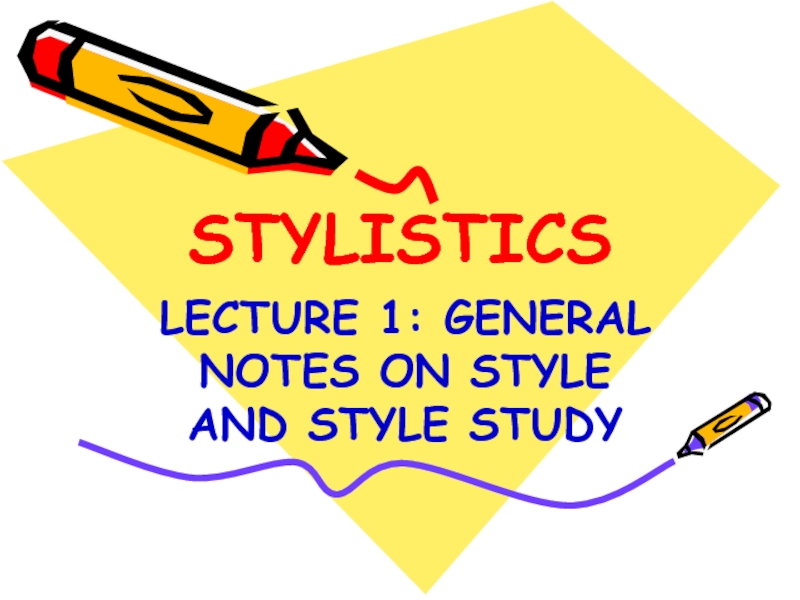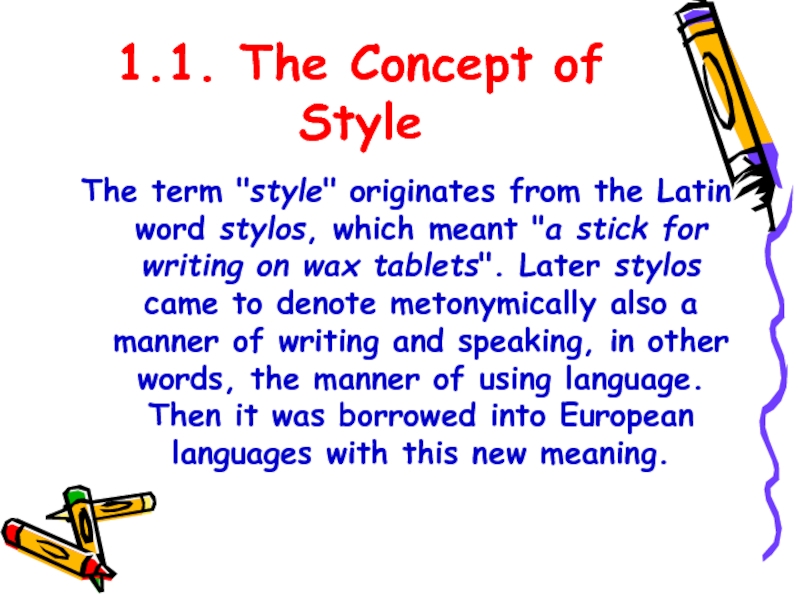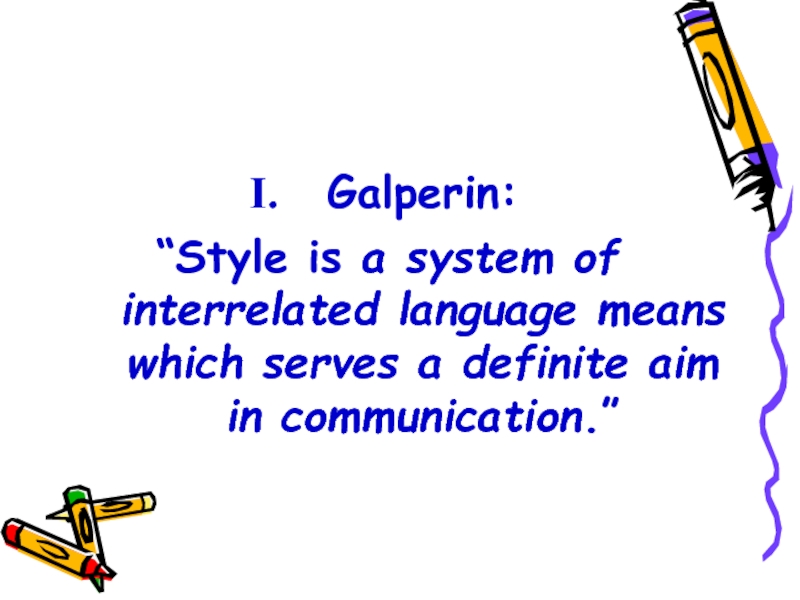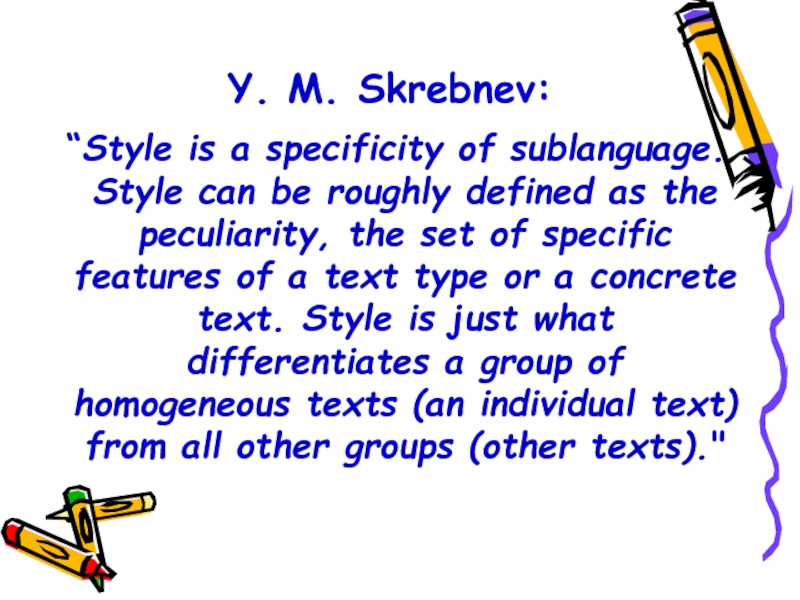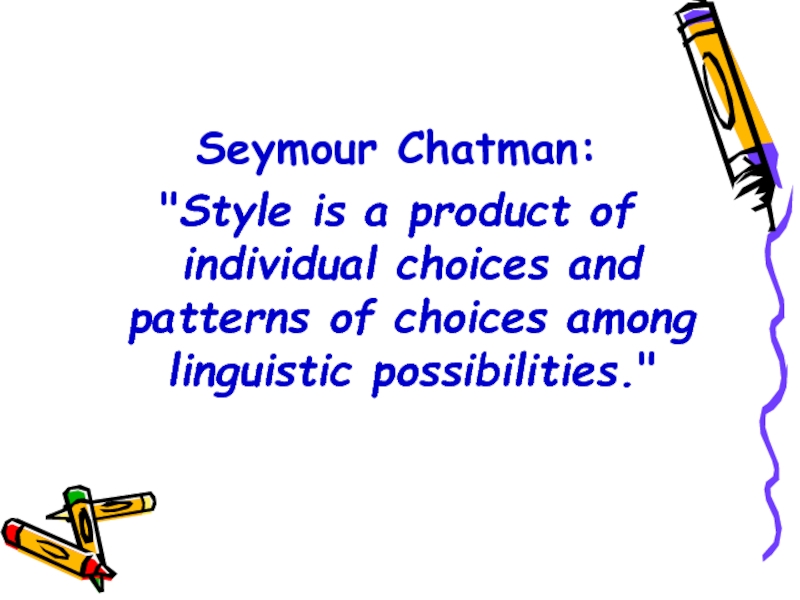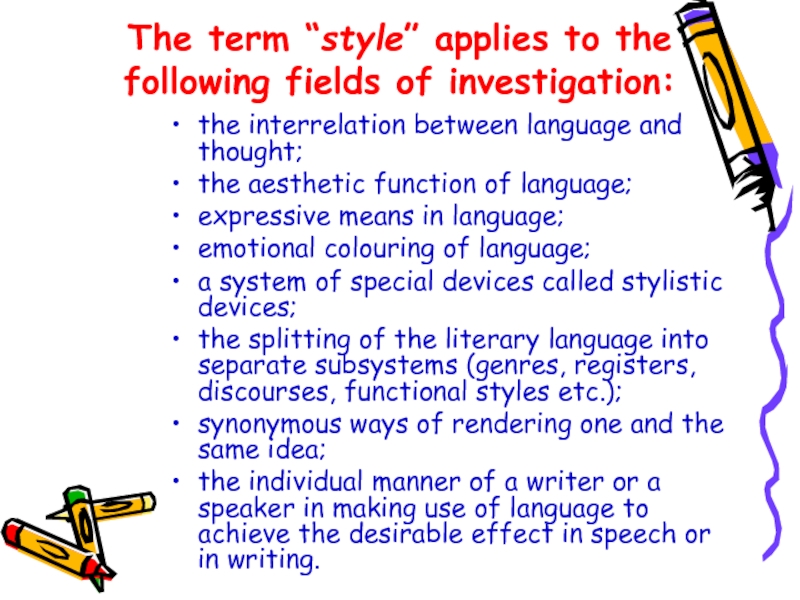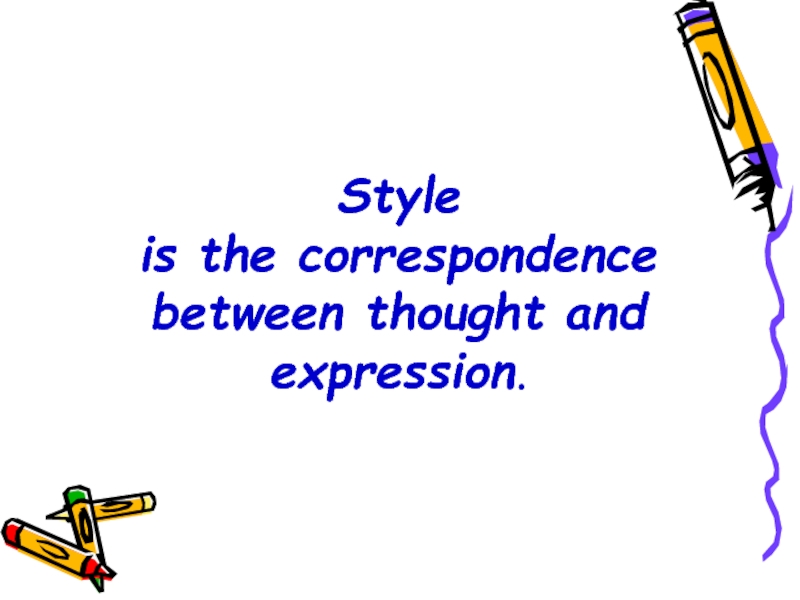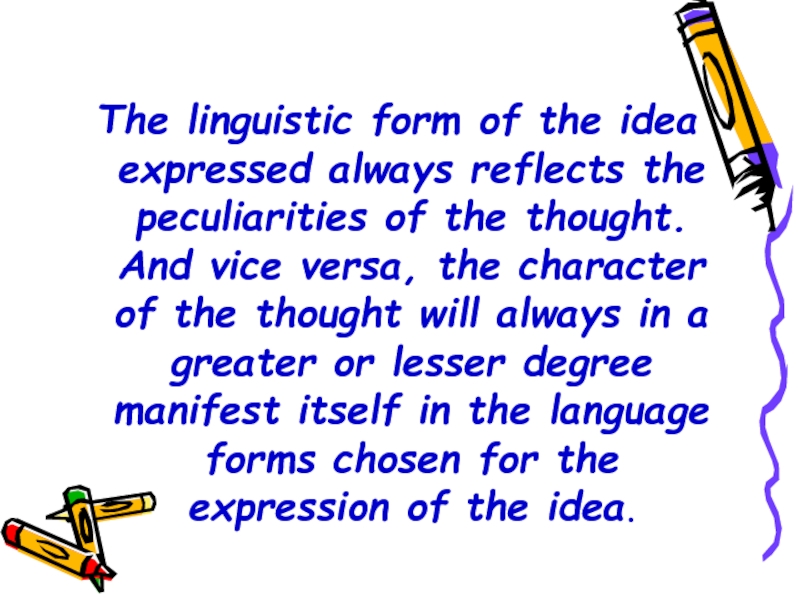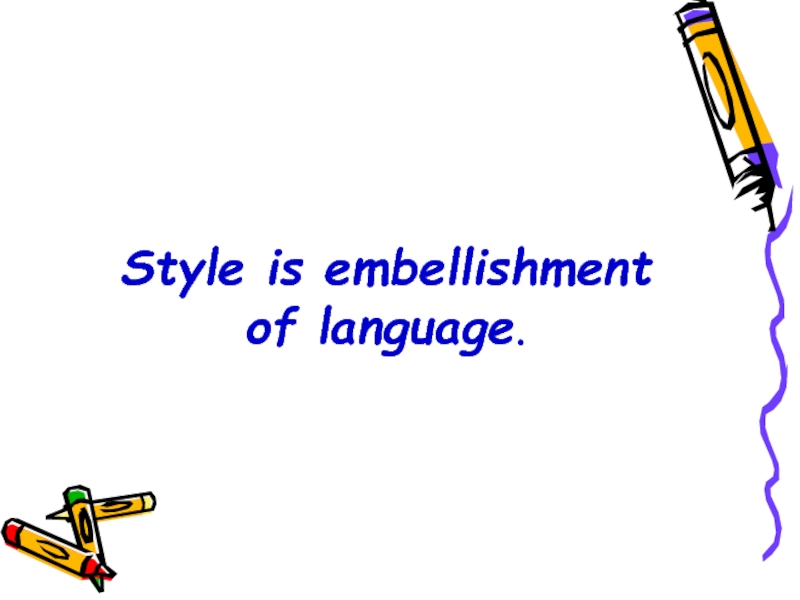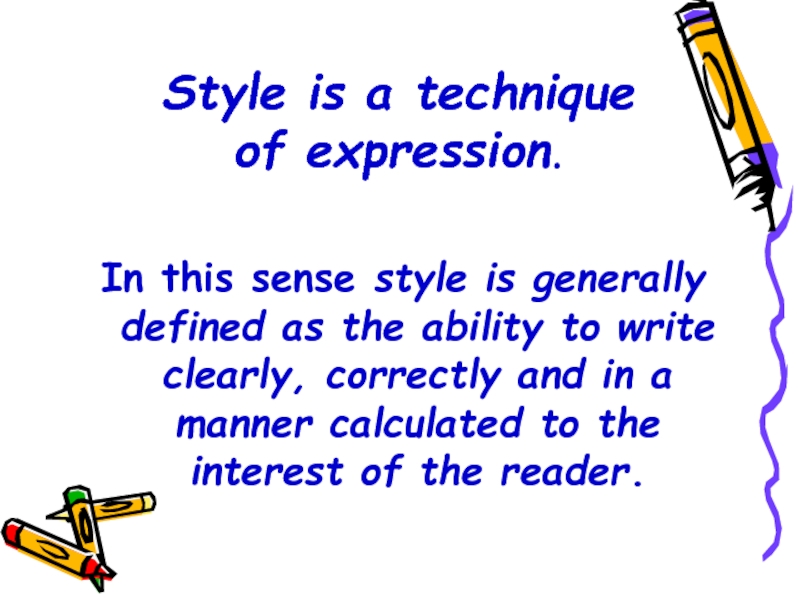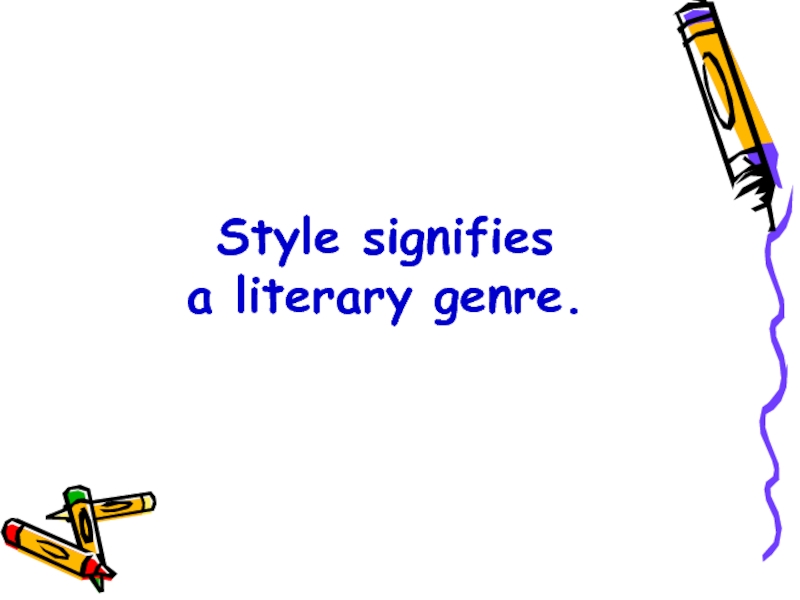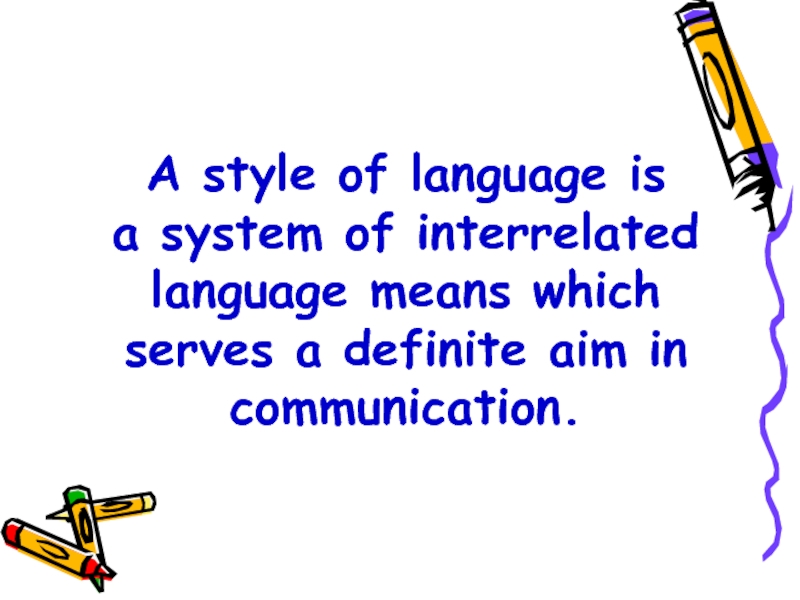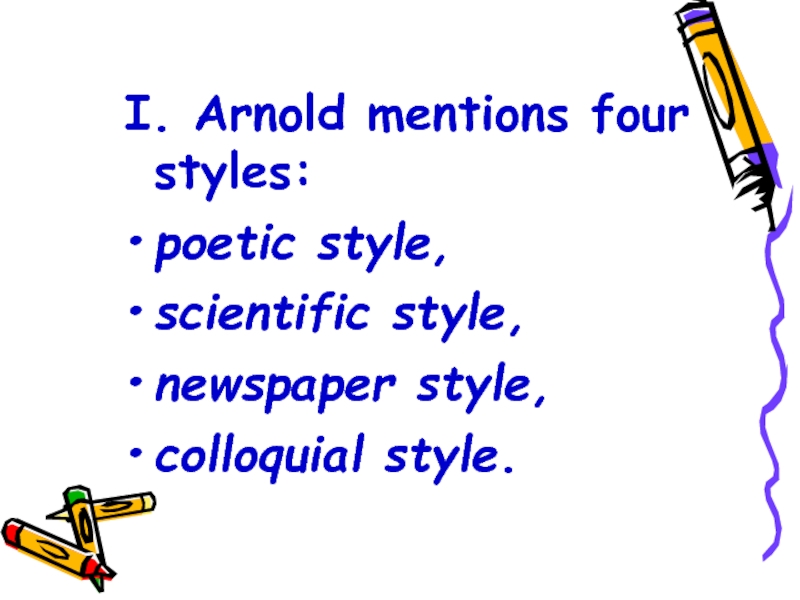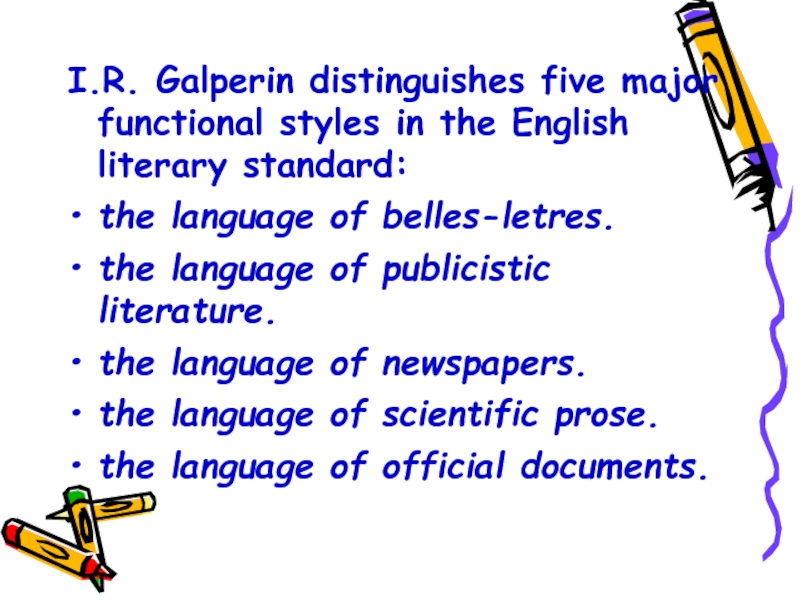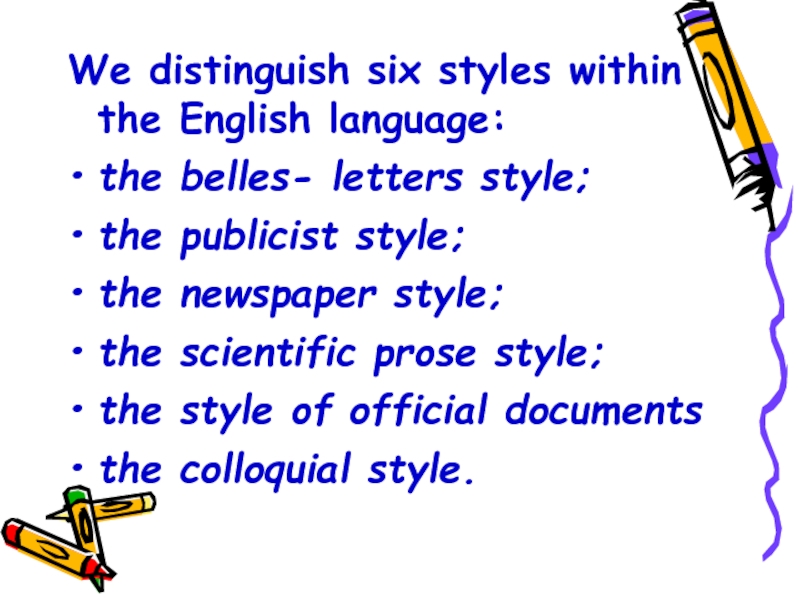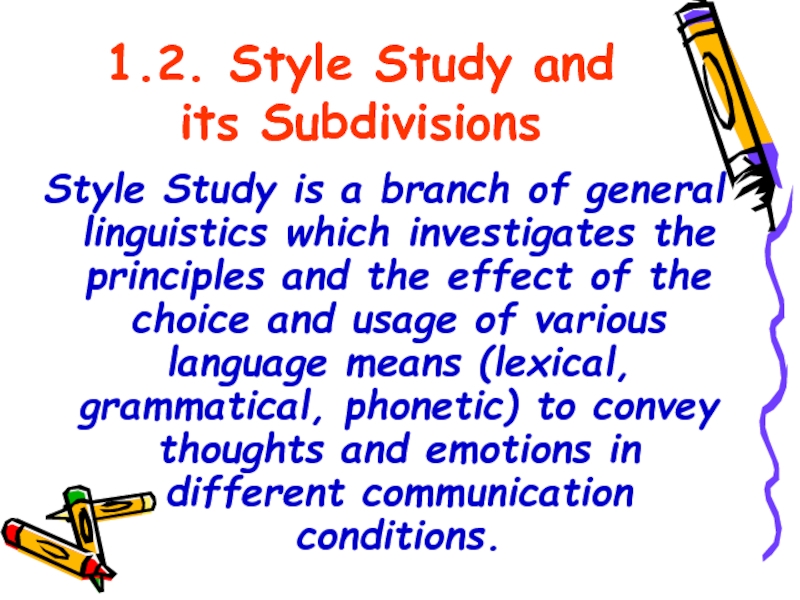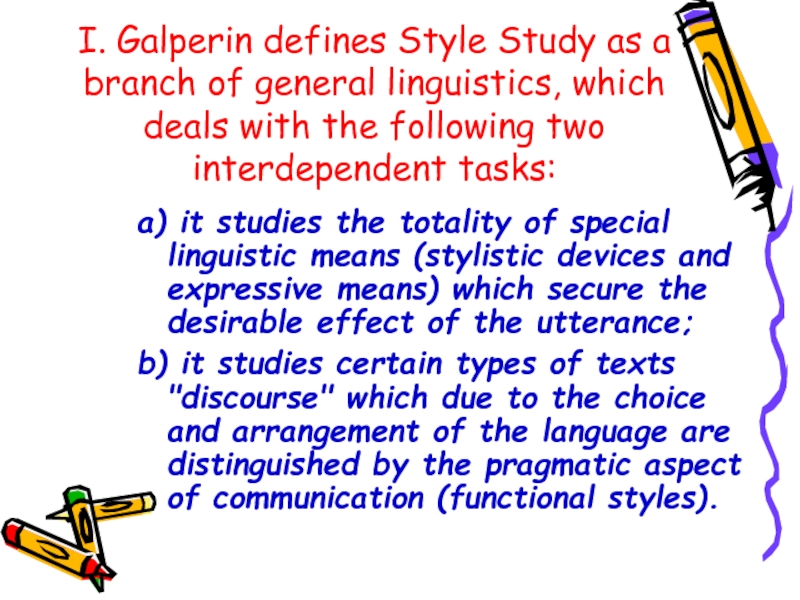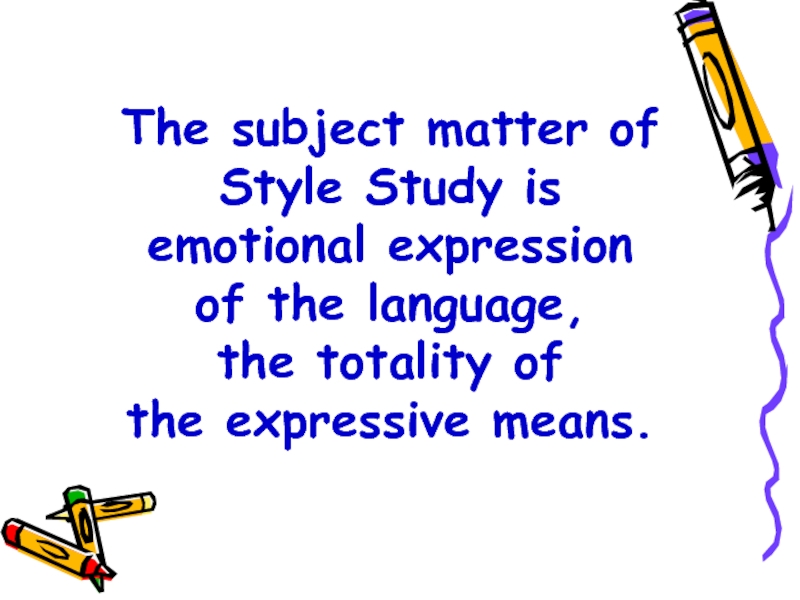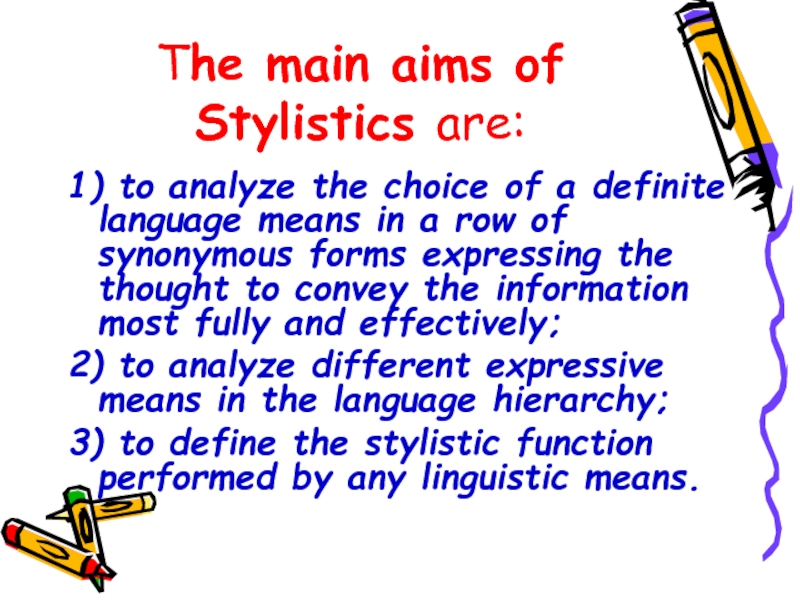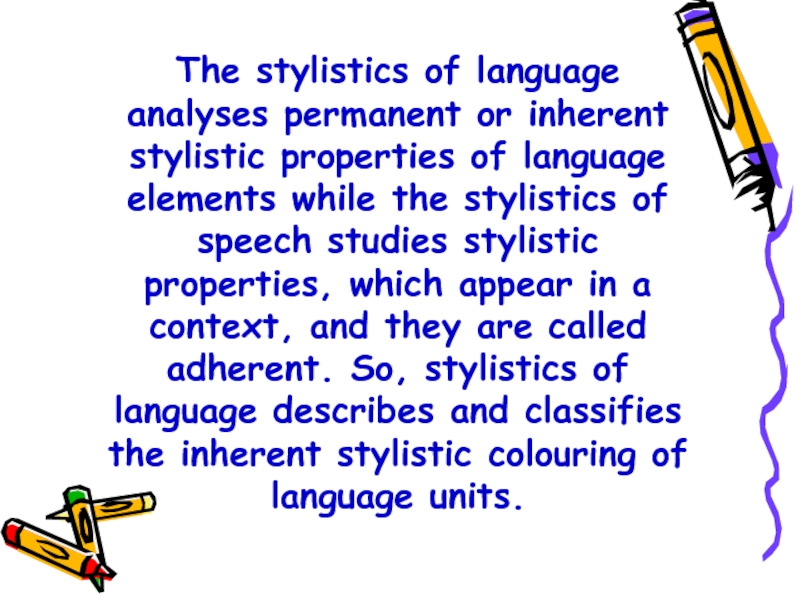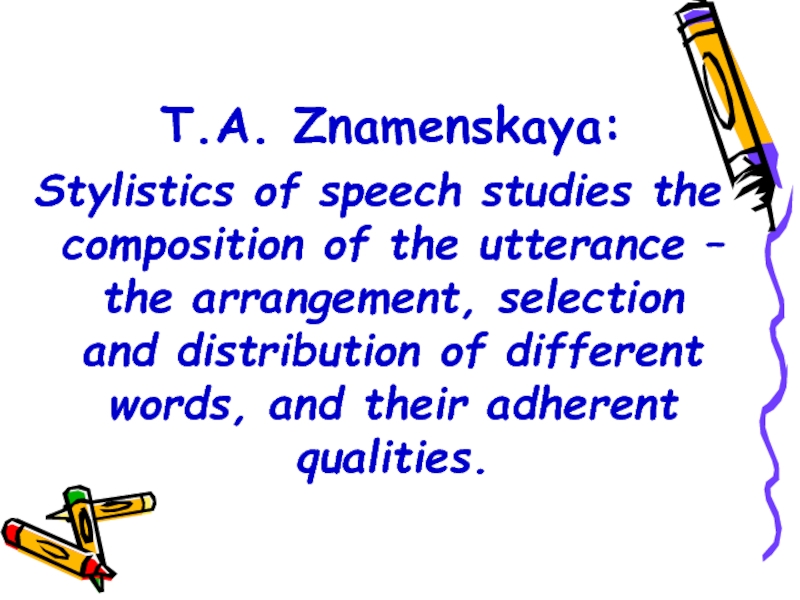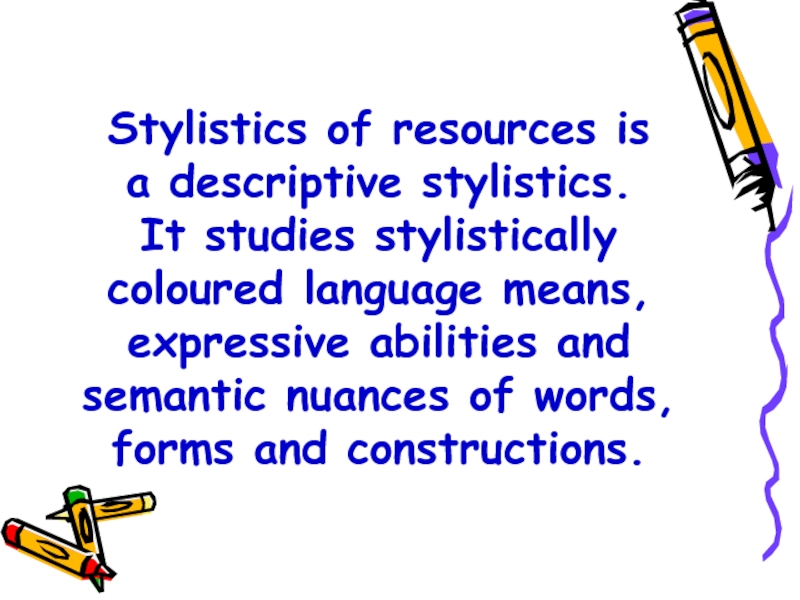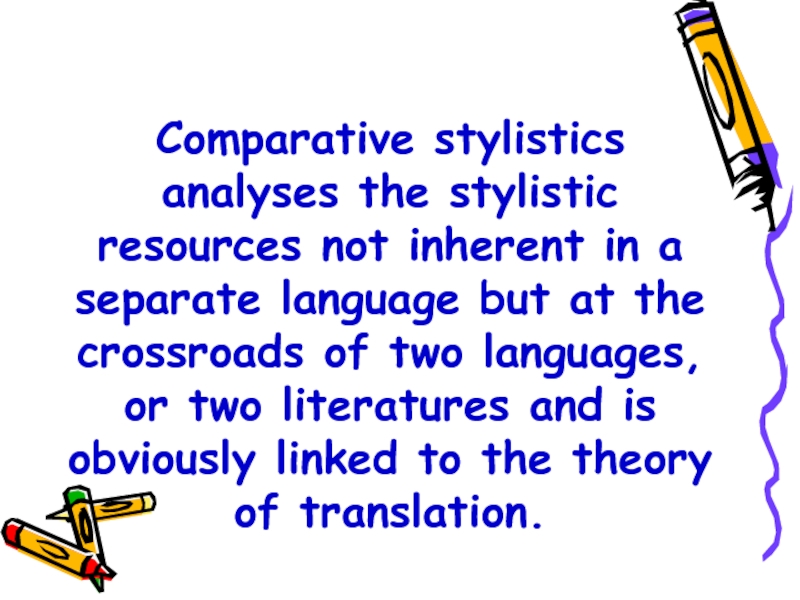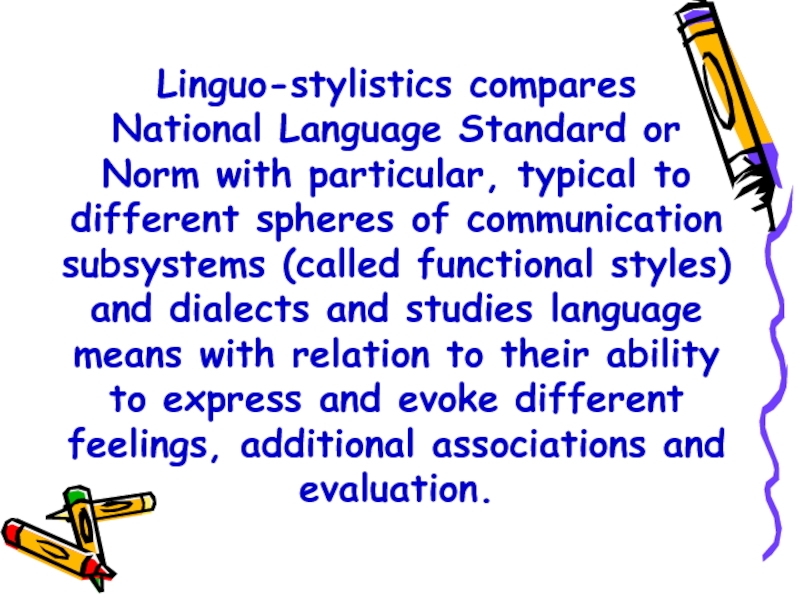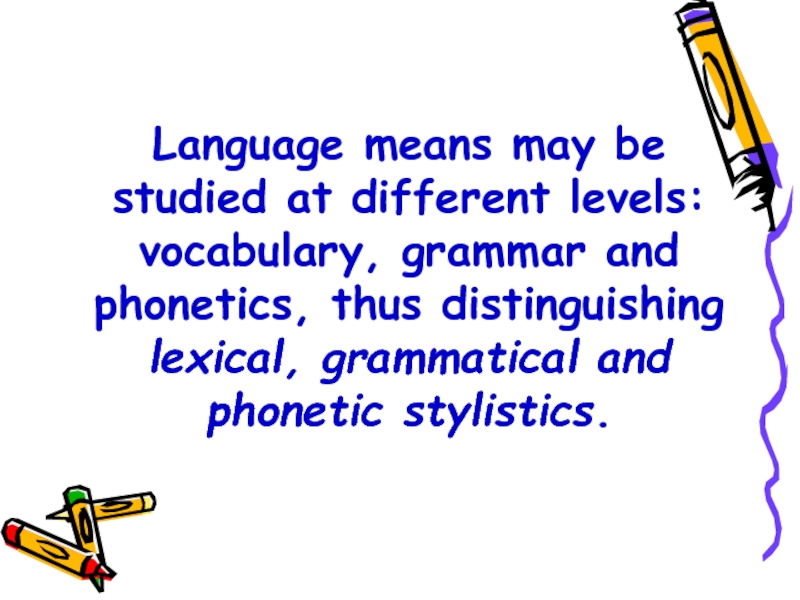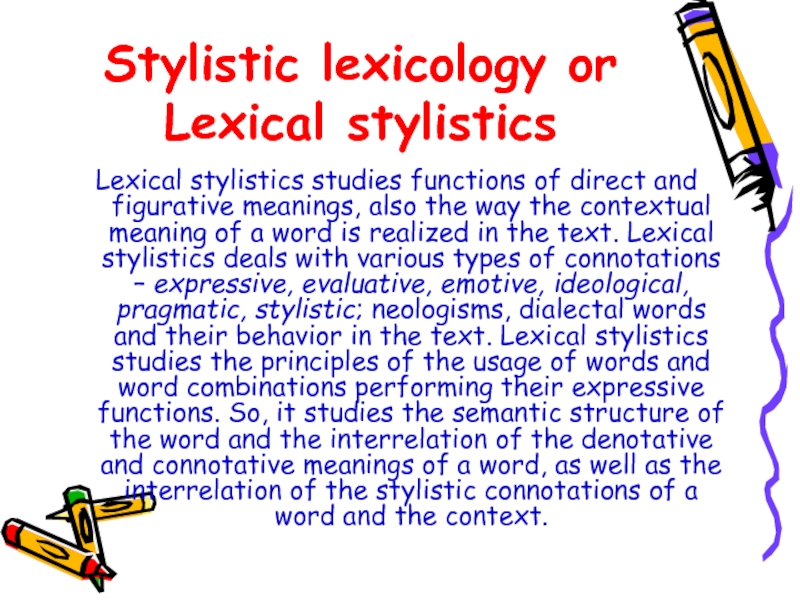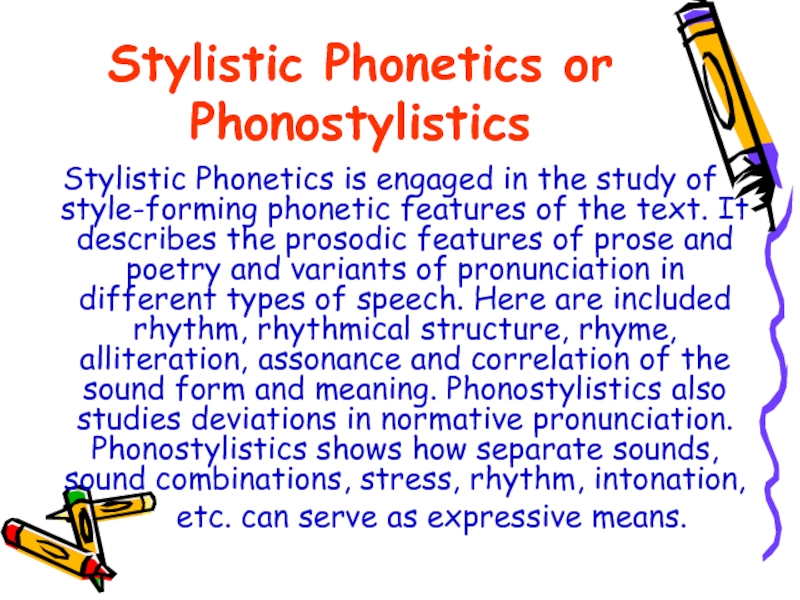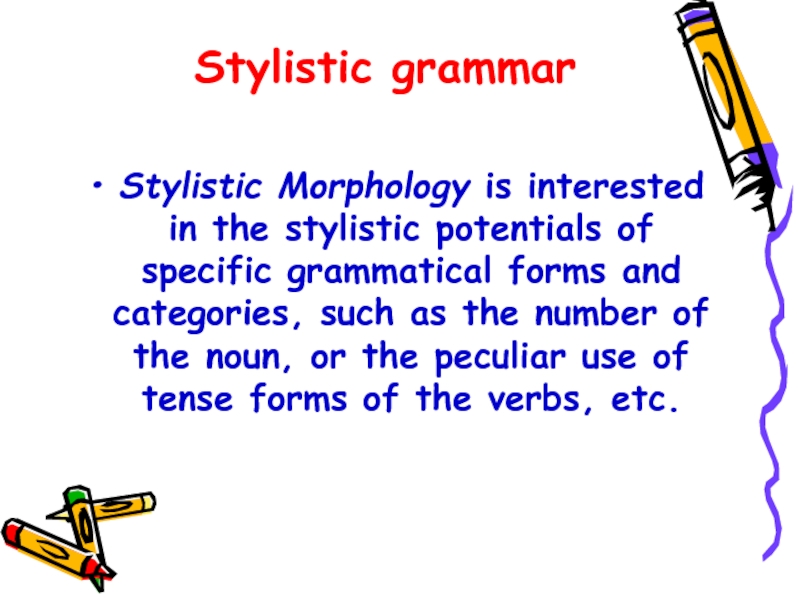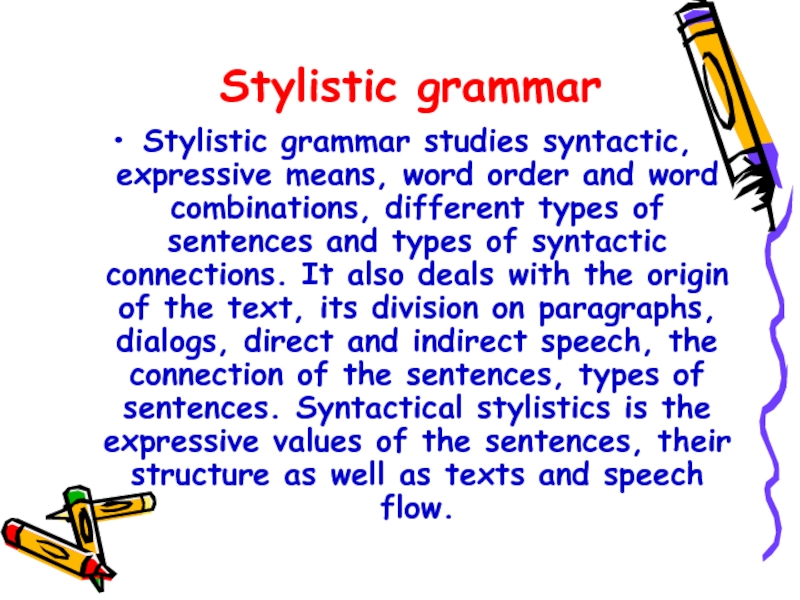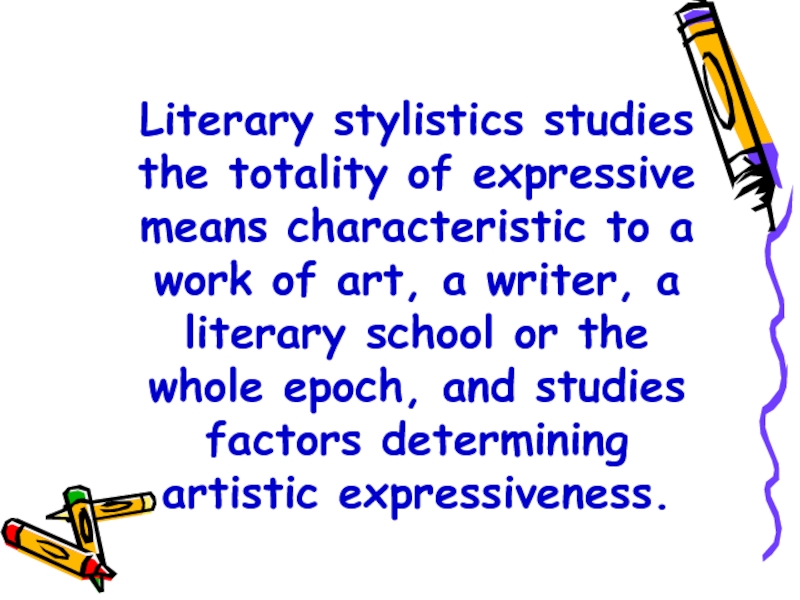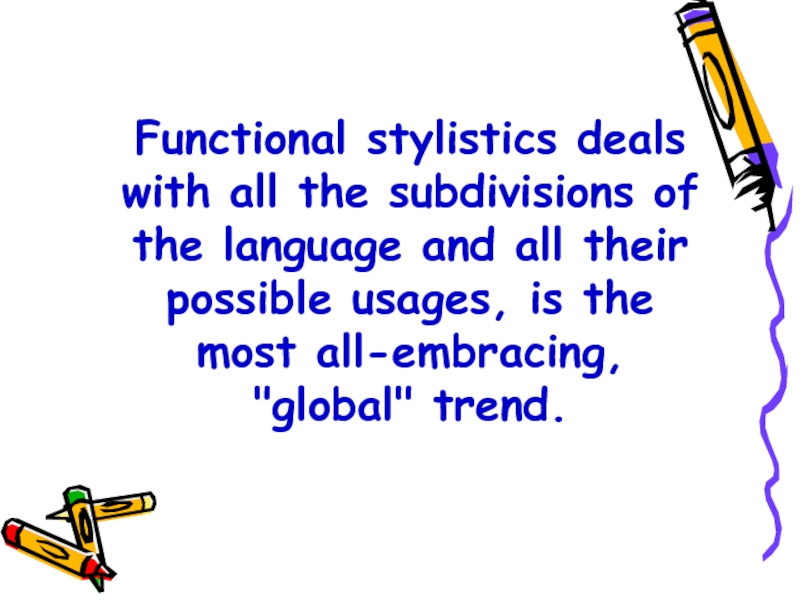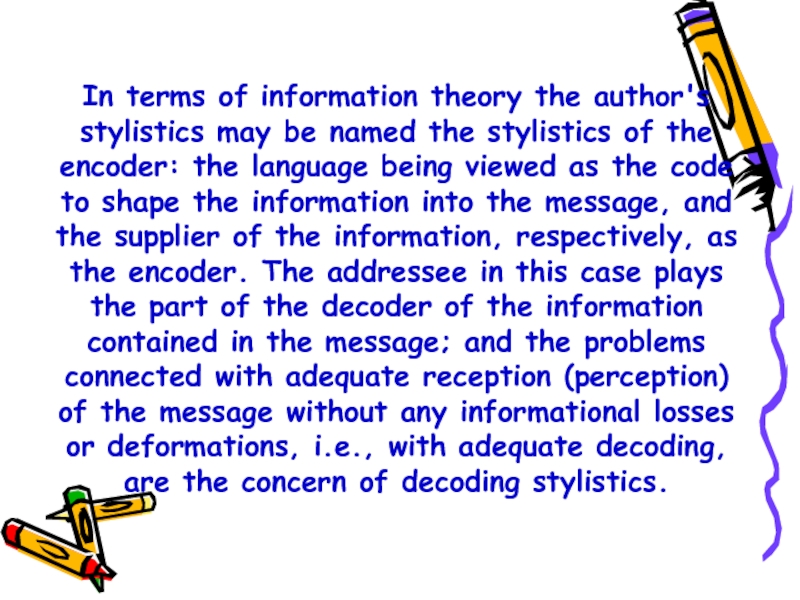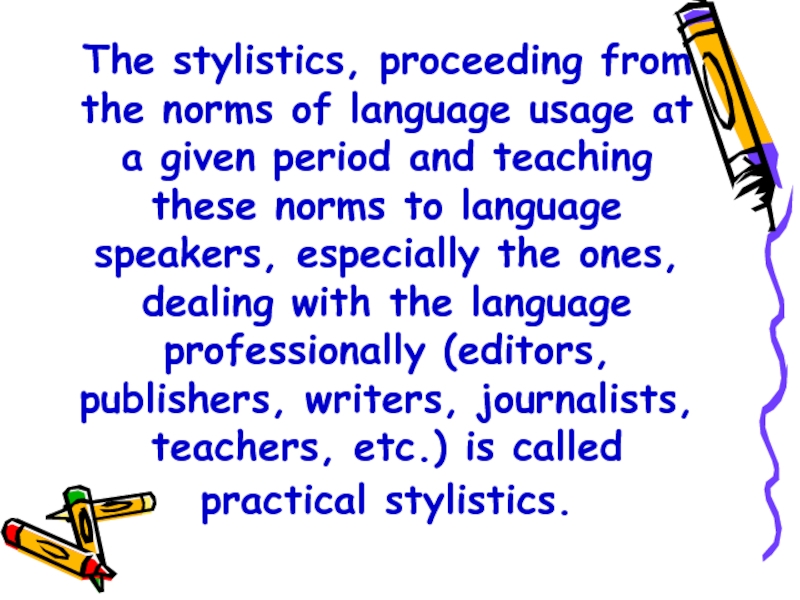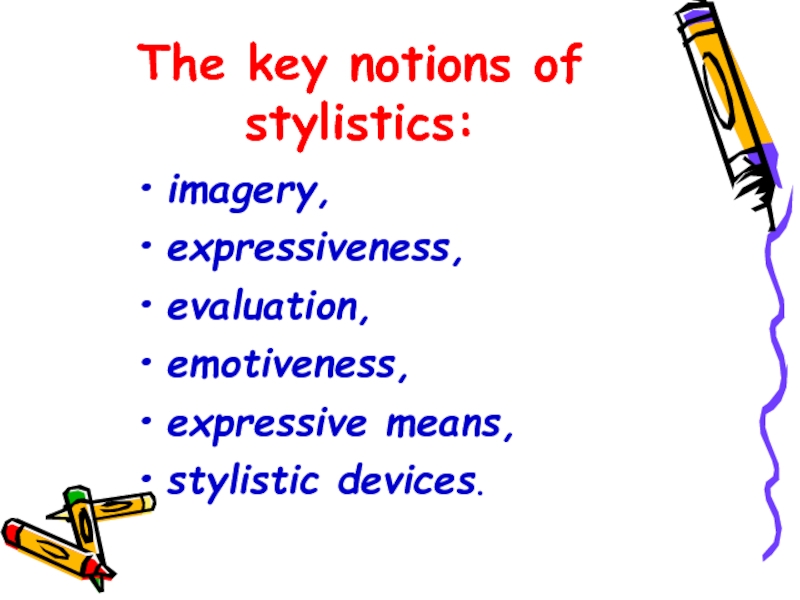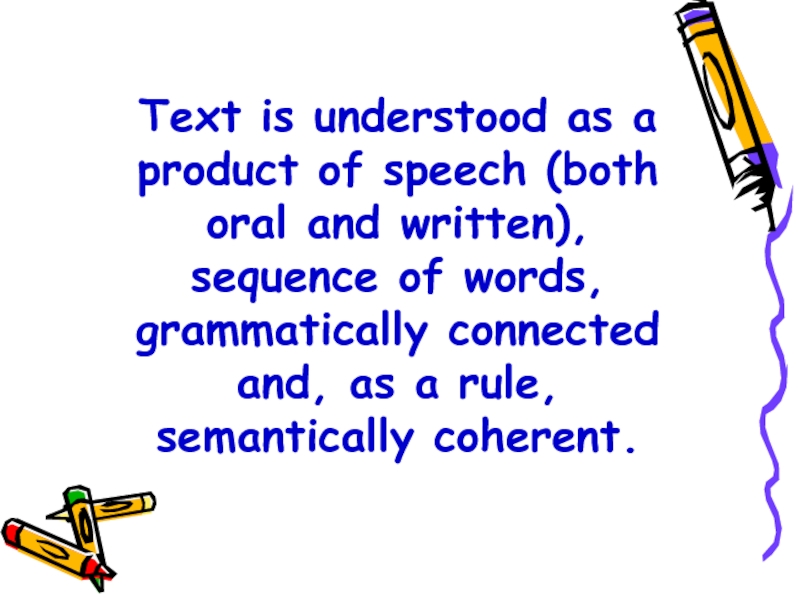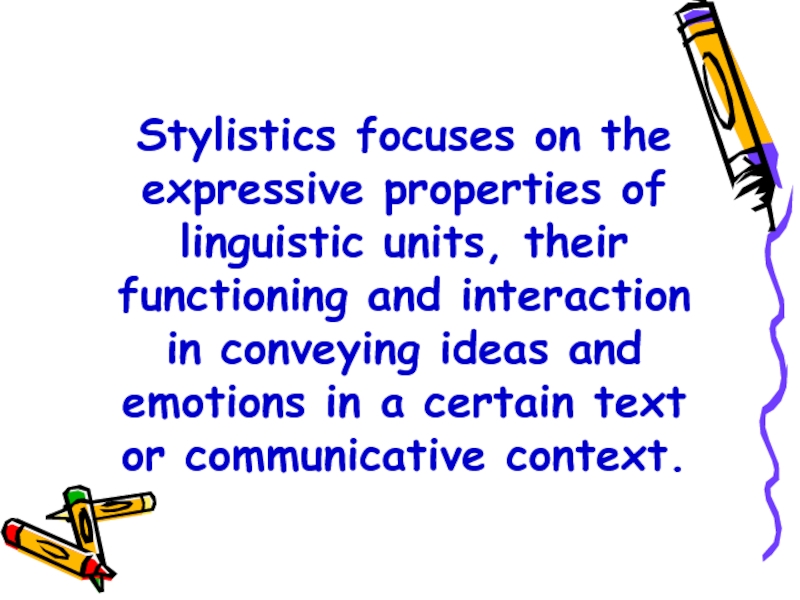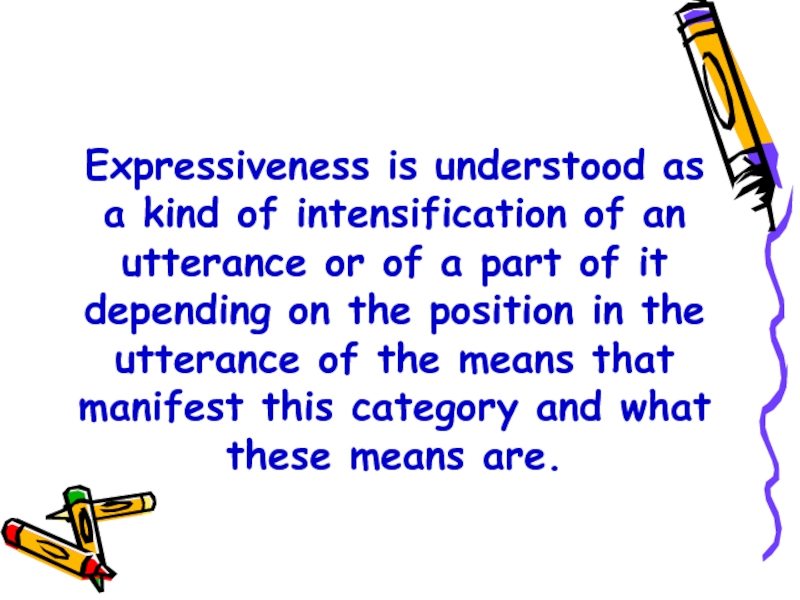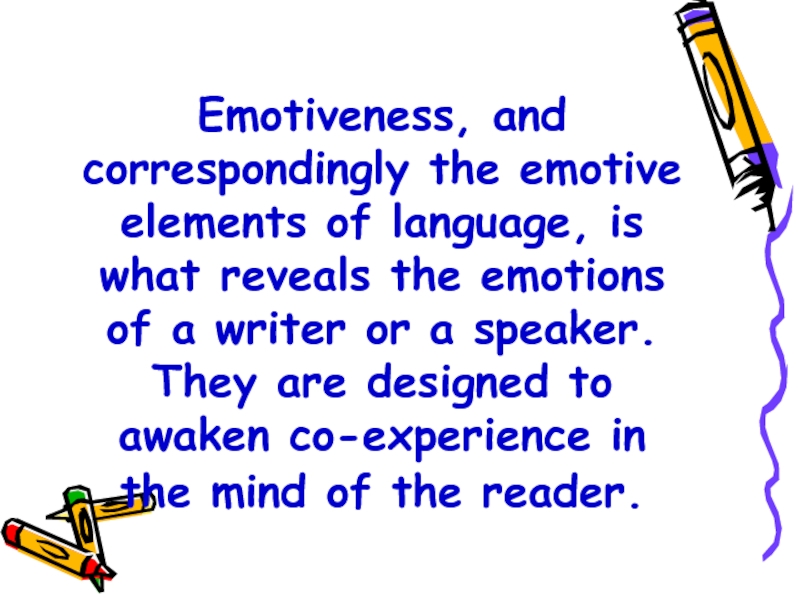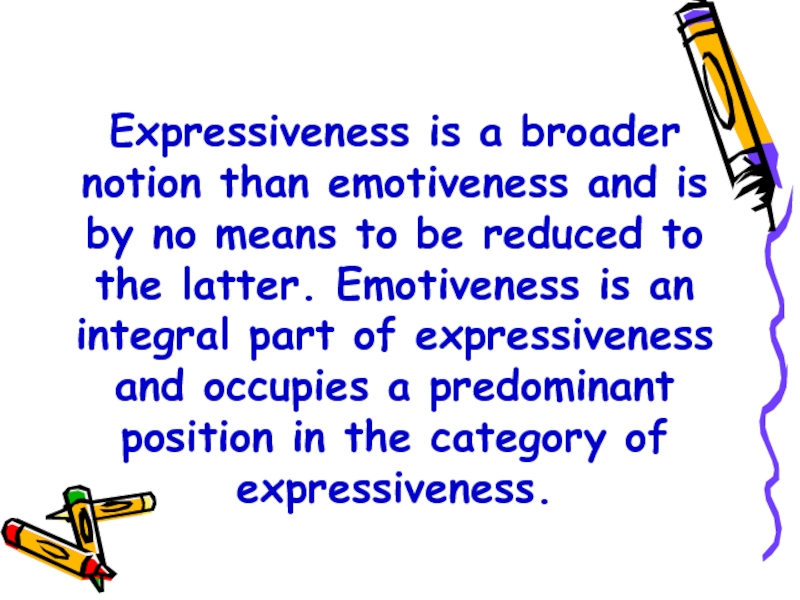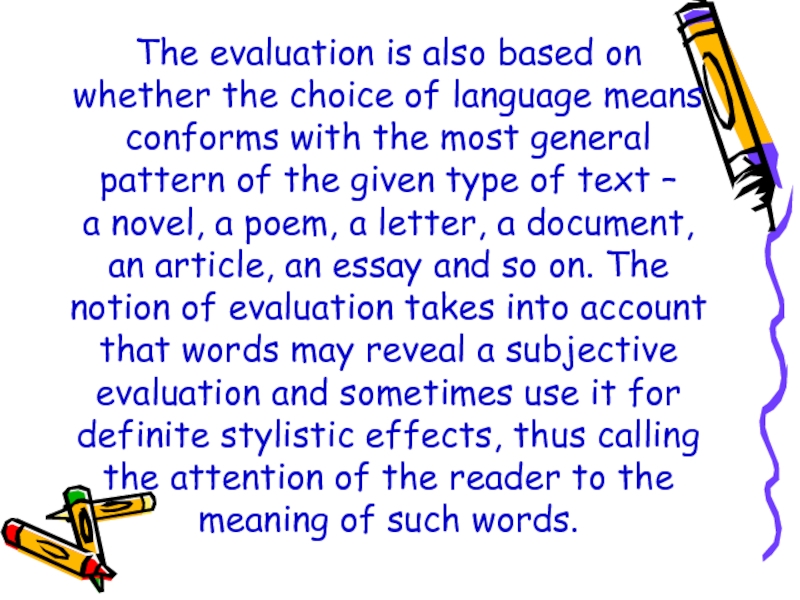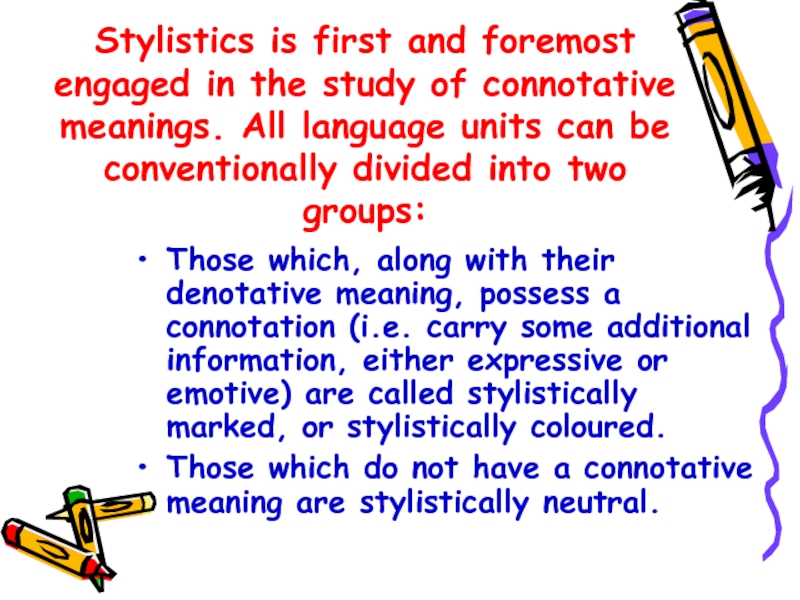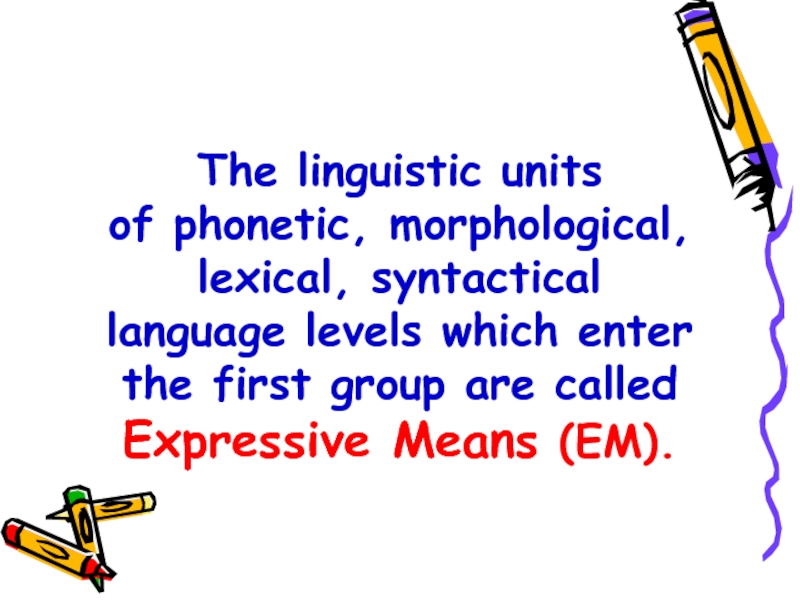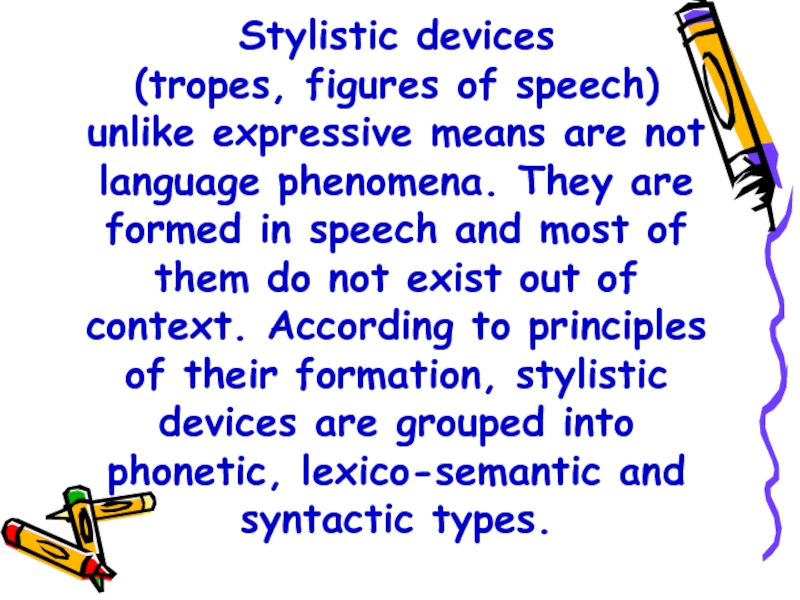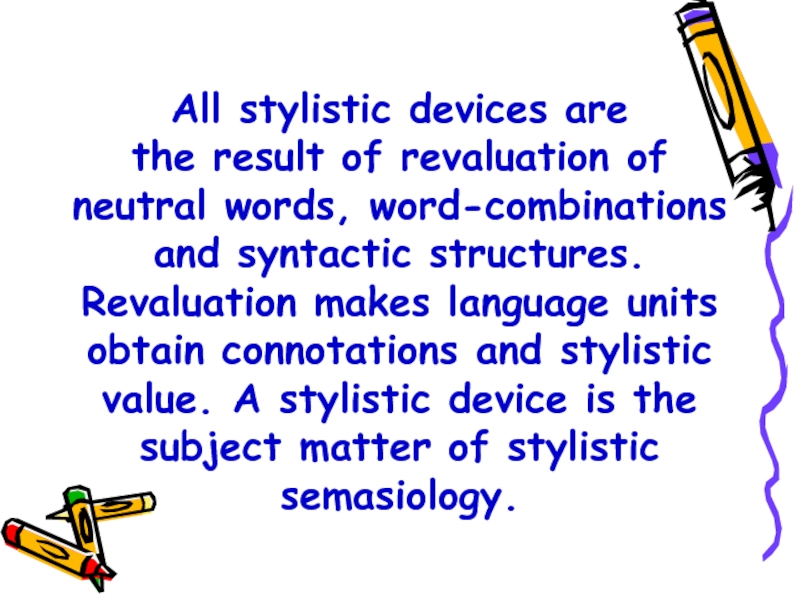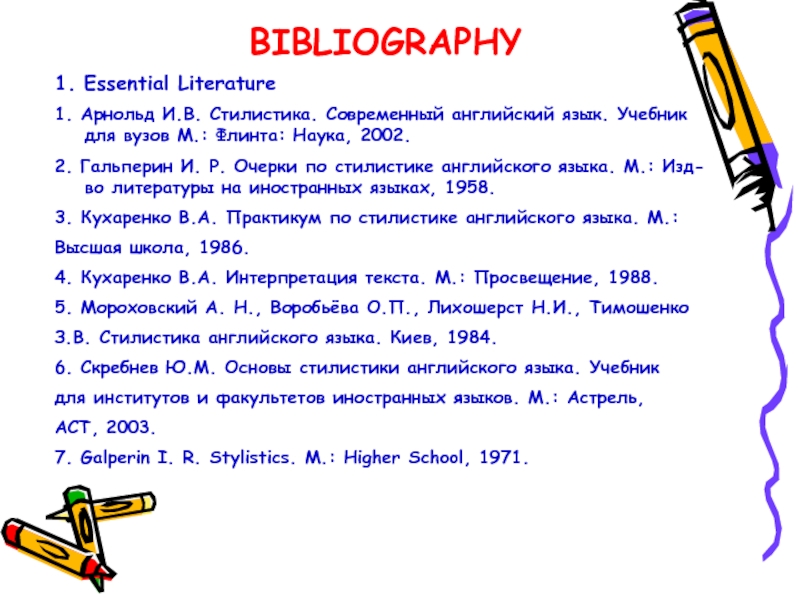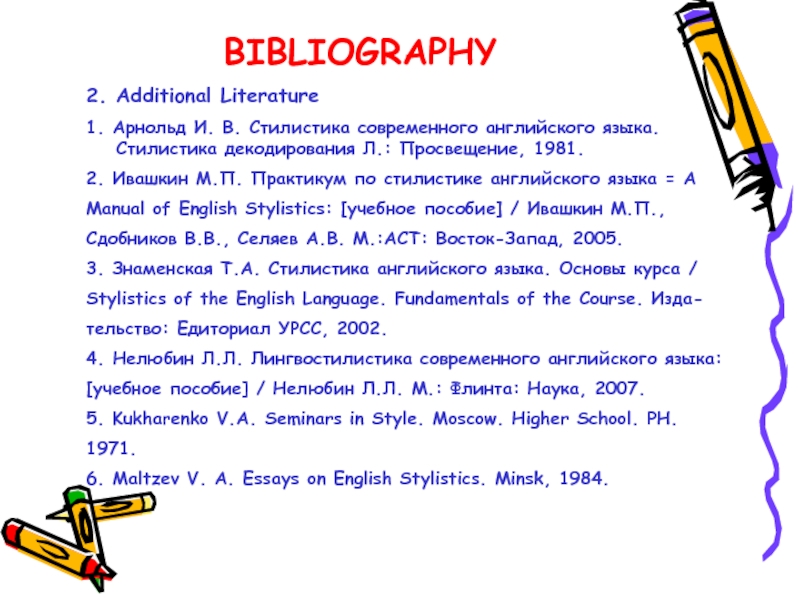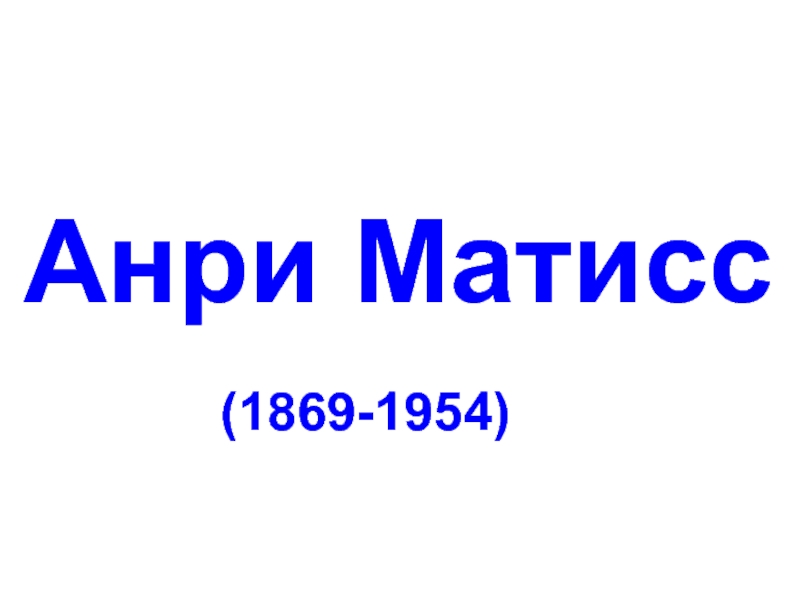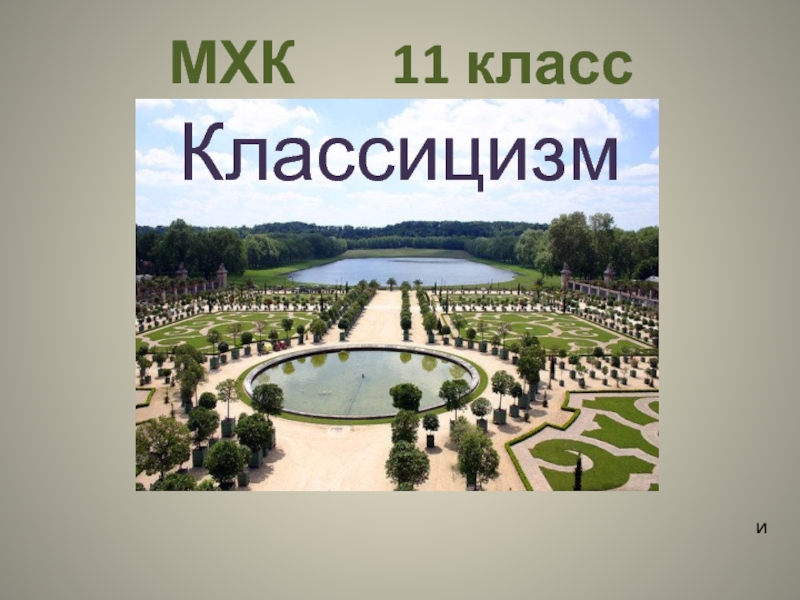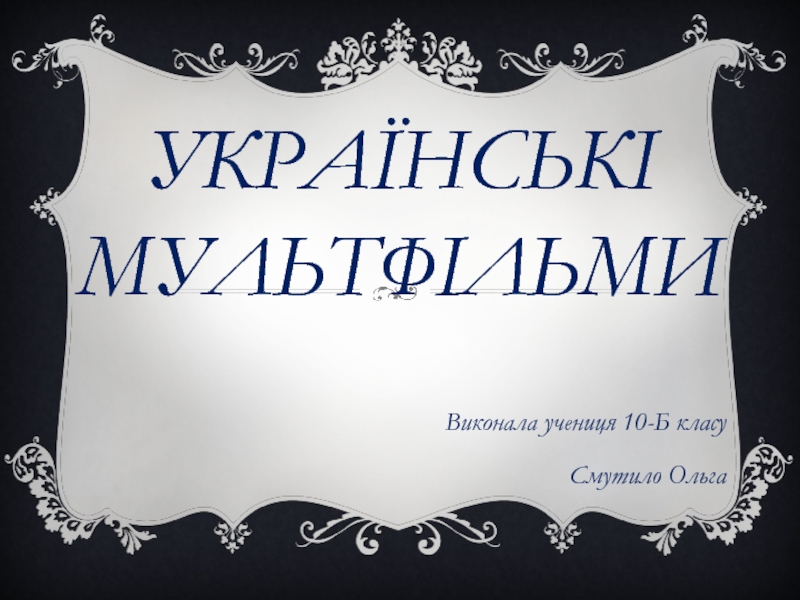- Главная
- Разное
- Дизайн
- Бизнес и предпринимательство
- Аналитика
- Образование
- Развлечения
- Красота и здоровье
- Финансы
- Государство
- Путешествия
- Спорт
- Недвижимость
- Армия
- Графика
- Культурология
- Еда и кулинария
- Лингвистика
- Английский язык
- Астрономия
- Алгебра
- Биология
- География
- Детские презентации
- Информатика
- История
- Литература
- Маркетинг
- Математика
- Медицина
- Менеджмент
- Музыка
- МХК
- Немецкий язык
- ОБЖ
- Обществознание
- Окружающий мир
- Педагогика
- Русский язык
- Технология
- Физика
- Философия
- Химия
- Шаблоны, картинки для презентаций
- Экология
- Экономика
- Юриспруденция
General notes on style and style study (lecture 1) презентация
Содержание
- 1. General notes on style and style study (lecture 1)
- 2. 1.1. The Concept of Style The term
- 3. Galperin: “Style is a system of
- 4. Y. M. Skrebnev: “Style is a
- 5. Seymour Chatman: "Style is a product of
- 6. The term “style” applies to the following
- 7. Style is the correspondence between thought and expression.
- 8. The linguistic form of the idea expressed
- 9. Style is embellishment of language.
- 10. Style is a technique of expression.
- 11. Style signifies a literary genre.
- 12. A style of language is a
- 13. I. Arnold mentions four styles: poetic
- 14. I.R. Galperin distinguishes five major functional styles
- 15. We distinguish six styles within the English
- 16. 1.2. Style Study and its Subdivisions Style
- 17. I. Galperin defines Style Study as a
- 18. The subject matter of Style Study is
- 19. The main aims of Stylistics are: 1)
- 20. The stylistics of language analyses permanent or
- 21. Т.A. Znamenskaya: Stylistics of speech studies
- 22. Stylistics of resources is a descriptive
- 23. Comparative stylistics analyses the stylistic resources not
- 24. Linguo-stylistics compares National Language Standard or
- 25. Language means may be studied at different
- 26. Stylistic lexicology or Lexical stylistics Lexical
- 27. Stylistic Phonetics or Phonostylistics Stylistic Phonetics is
- 28. Stylistic grammar Stylistic Morphology is interested
- 29. Stylistic grammar Stylistic grammar studies syntactic, expressive
- 30. Literary stylistics studies the totality of expressive
- 31. Functional stylistics deals with all the subdivisions
- 32. In terms of information theory the author's
- 33. The stylistics, proceeding from the norms of
- 34. The key notions of stylistics: imagery,
- 35. Text is understood as a product of
- 36. Stylistics focuses on the expressive properties of
- 37. Expressiveness is understood as a kind of
- 38. Emotiveness, and correspondingly the emotive elements of
- 39. Expressiveness is a broader notion than emotiveness
- 40. The evaluation is also based on whether
- 41. Stylistics is first and foremost engaged in
- 42. The linguistic units of phonetic, morphological,
- 43. Stylistic devices (tropes, figures of speech)
- 44. All stylistic devices are the result
- 45. THANK YOU FOR YOUR ATTENTION!
- 46. BIBLIOGRAPHY 1. Essential Literature 1. Арнольд И.В.
- 47. BIBLIOGRAPHY 2. Additional Literature 1. Арнольд И.
Слайд 21.1. The Concept of Style
The term "style" originates from the Latin
Слайд 3Galperin:
“Style is a system of interrelated language means which serves
Слайд 4Y. M. Skrebnev:
“Style is a specificity of sublanguage. Style can
Слайд 5Seymour Chatman:
"Style is a product of individual choices and patterns of
Слайд 6The term “style” applies to the following fields of investigation:
the interrelation
the aesthetic function of language;
expressive means in language;
emotional colouring of language;
a system of special devices called stylistic devices;
the splitting of the literary language into separate subsystems (genres, registers, discourses, functional styles etc.);
synonymous ways of rendering one and the same idea;
the individual manner of a writer or a speaker in making use of language to achieve the desirable effect in speech or in writing.
Слайд 8The linguistic form of the idea expressed always reflects the peculiarities
Слайд 10Style is a technique
of expression.
In this sense style is
Слайд 12A style of language is a system of interrelated language means
Слайд 13I. Arnold mentions four styles:
poetic style,
scientific style,
newspaper style,
colloquial style.
Слайд 14I.R. Galperin distinguishes five major functional styles in the English literary
the language of belles-letres.
the language of publicistic literature.
the language of newspapers.
the language of scientific prose.
the language of official documents.
Слайд 15We distinguish six styles within the English language:
the belles- letters style;
the
the newspaper style;
the scientific prose style;
the style of official documents
the colloquial style.
Слайд 161.2. Style Study and its Subdivisions
Style Study is a branch of
Слайд 17I. Galperin defines Style Study as a branch of general linguistics,
a) it studies the totality of special linguistic means (stylistic devices and expressive means) which secure the desirable effect of the utterance;
b) it studies certain types of texts "discourse" which due to the choice and arrangement of the language are distinguished by the pragmatic aspect of communication (functional styles).
Слайд 18The subject matter of Style Study is emotional expression of the
Слайд 19The main aims of Stylistics are:
1) to analyze the choice of
2) to analyze different expressive means in the language hierarchy;
3) to define the stylistic function performed by any linguistic means.
Слайд 20The stylistics of language analyses permanent or inherent stylistic properties of
Слайд 21Т.A. Znamenskaya:
Stylistics of speech studies the composition of the utterance
Слайд 22Stylistics of resources is a descriptive stylistics. It studies stylistically coloured
Слайд 23Comparative stylistics analyses the stylistic resources not inherent in a separate
Слайд 24Linguo-stylistics compares National Language Standard or Norm with particular, typical to
Слайд 25Language means may be studied at different levels: vocabulary, grammar and
Слайд 26Stylistic lexicology or Lexical stylistics
Lexical stylistics studies functions of direct
Слайд 27Stylistic Phonetics or Phonostylistics
Stylistic Phonetics is engaged in the study of
etc. can serve as expressive means.
Слайд 28Stylistic grammar
Stylistic Morphology is interested in the stylistic potentials of
Слайд 29Stylistic grammar
Stylistic grammar studies syntactic, expressive means, word order and word
Слайд 30Literary stylistics studies the totality of expressive means characteristic to a
Слайд 31Functional stylistics deals with all the subdivisions of the language and
Слайд 32In terms of information theory the author's stylistics may be named
Слайд 33The stylistics, proceeding from the norms of language usage at a
Слайд 34The key notions of stylistics:
imagery,
expressiveness,
evaluation,
emotiveness,
expressive means,
stylistic
Слайд 35Text is understood as a product of speech (both oral and
Слайд 36Stylistics focuses on the expressive properties of linguistic units, their functioning
Слайд 37Expressiveness is understood as a kind of intensification of an utterance
Слайд 38Emotiveness, and correspondingly the emotive elements of language, is what reveals
Слайд 39Expressiveness is a broader notion than emotiveness and is by no
Слайд 40The evaluation is also based on whether the choice of language
Слайд 41Stylistics is first and foremost engaged in the study of connotative
Those which, along with their denotative meaning, possess a connotation (i.e. carry some additional information, either expressive or emotive) are called stylistically marked, or stylistically coloured.
Those which do not have a connotative meaning are stylistically neutral.
Слайд 42The linguistic units of phonetic, morphological, lexical, syntactical language levels which
Слайд 43Stylistic devices (tropes, figures of speech) unlike expressive means are not
Слайд 44All stylistic devices are the result of revaluation of neutral words,
Слайд 46BIBLIOGRAPHY
1. Essential Literature
1. Арнольд И.В. Стилистика. Современный английский язык. Учебник для
2. Гальперин И. Р. Очерки по стилистике английского языка. М.: Изд-во литературы на иностранных языках, 1958.
3. Кухаренко В.А. Практикум по стилистике английского языка. М.:
Высшая школа, 1986.
4. Кухаренко В.А. Интерпретация текста. М.: Просвещение, 1988.
5. Мороховский А. Н., Воробьёва О.П., Лихошерст Н.И., Тимошенко
З.В. Стилистика английского языка. Киев, 1984.
6. Скребнев Ю.М. Основы стилистики английского языка. Учебник
для институтов и факультетов иностранных языков. М.: Астрель,
АСТ, 2003.
7. Galperin I. R. Stylistics. M.: Higher School, 1971.
Слайд 47BIBLIOGRAPHY
2. Additional Literature
1. Арнольд И. В. Стилистика современного английского языка. Стилистика
2. Ивашкин М.П. Практикум по стилистике английского языка = A
Manual of English Stylistics: [учебное пособие] / Ивашкин М.П.,
Сдобников В.В., Селяев А.В. М.:АСТ: Восток-Запад, 2005.
3. Знаменская Т.А. Стилистика английского языка. Основы курса /
Stylistics of the English Language. Fundamentals of the Course. Изда-
тельство: Едиториал УРСС, 2002.
4. Нелюбин Л.Л. Лингвостилистика современного английского языка:
[учебное пособие] / Нелюбин Л.Л. M.: Флинта: Наука, 2007.
5. Kukharenko V.A. Seminars in Style. Moscow. Higher School. PH.
1971.
6. Maltzev V. A. Essays on English Stylistics. Minsk, 1984.
